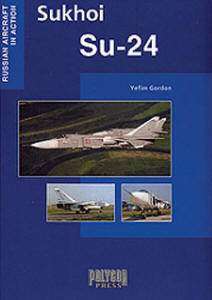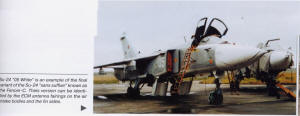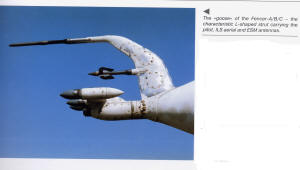|
Polygon Press |
|
Sukhoi Su-24 Russian Aircraft In Action |
|
by Yefim Gordon |
|
Reviewed By Jim Pearsall, #2209 |
|
|
| MSRP: $17.95 USD U.S. Distributor, Specialty Press 39966 Grand Ave North Branch, MN, 55056 The basics: Hardbound, 80 pages, 11.5’ X 9” (A4?), more than 200 photos, including color. 10 side view color profiles and 1/72 3-view drawing. The aircraft: The Su-24 started out as a conventional wing aircraft with lift engines, rather like the Yak-36 “Forger”. The design was changed radically to a variable sweep wing when it was decided that the lift engines were of low utility. The requirement for supersonic performance at low altitude with short field capability/slow landing speed resulted in the same solutions arrived at by GD with the F-111, Grumman with the F-14, Panavia with the Tornado, and MiG with the MiG-23. The “Fencer B” was used in Afghanistan, and the Su-24MK has been exported to Syria, Libya, Iraq and Iran. Former Soviet Republics Russia and Ukraine still use the Su-24 as their main tactical strike aircraft. The contents: The first 3 pages (3-5) are operational and development history. It’s done in about 9-point type, so there’s a lot of information there. Then 70 pages of color photos. No b/w. Each photo has a caption. 2 pages of side view color profiles, and 1 page of line drawings in 1/72. Usefulness as a modeling reference: High. The color photos are not just taken over an airfield fence with a medium lens, or amidst a crowd at some air show. They were either taken by the author or two other individuals, or from Sukhoi OKB archives or Air Forces Monthly magazine. These are carefully composed shots ranging from entire aircraft to detail photos of hard to see subassemblies. The captions of the photos and the text should be read carefully, as they contain a lot of little “gems” which can make a difference in a model. |
| This scan of the “goose neck” air data boom on the nose of a Fencer A/B/C is from a 4” X 5” photo. |
| And it’s
all here. Both cockpits, with close ups, including one with the aircraft powered up, so the lights are evident.
Landing gear detail shots. Canopies open, with a view of what it looks like back there where the hinges are, and
with the boarding ladders in place. The little fins on the front of the 3000 liter drop tanks which have negative
incidence to keep the tank from hitting the wing when it’s dropped. Why you should build your model with the
horizontal stabilizers deflected full down. Pylons and armament configurations. The photos may disappoint rivet counters, as I didn’t see that many, but there are a bazillion Phillips flush head screws on these aircraft. The color profiles for markings are a little small, but if there’s any question, the aircraft shown are also featured in photos elsewhere in the book. Markings are featured for USSR, Russia, Ukraine, Iraq, and Iran. The line drawing is of an Su-24M. Personal observations: Good information on former Soviet aircraft is finally becoming available. This book is a great information and detail source. With Zvezda’s Su-24M available in 1/72, and DML’s 1/72 “Fencer C” out there (I picked one up at a swap meet last year), the opportunity to build a really nice model exists. The photos in this book would be hard to obtain from a USAF base, unless you were stationed there, or had a pilot friend. The fact that they were taken at active Russian and Ukrainian bases is just mind boggling. Most of us remember when the best photos available of Soviet aircraft were taken at the May Day flyover over Red Square. I had a suspicion that the Soviets built fuzzy airplanes, because the only photos of them were poor and so out of focus that no detail was visible. That has changed. For the better. If the other books in this series are as good as this one, I need to buy the ones for the MiG-23, the Tu-95 and the Tu-22. |
|
Information, images, and all
other items placed electronically on this site |


